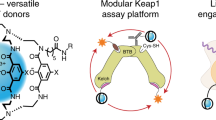
Overview
- Builds on the reputation and historical significance of the Topics in Current Chemistry book series
- Presents comprehensive reviews of established and emerging topics in modern chemical research
- Supervised by Editors and an Editorial Board of world-leading chemists
Part of the book series: Topics in Current Chemistry Collections (TCCC)
Access this book
Tax calculation will be finalised at checkout
Other ways to access
About this book
Each review within the volume critically surveys one aspect of that topic and places it within the context of the volume as a whole. The most significant developments of the last 5 to 10 years are presented using selected examples to illustrate the principles discussed. The coverage is not intended to be an exhaustive summary of the field or include large quantities of data, but should rather be conceptual, concentrating on the methodological thinking that will allow the non-specialist reader to understand the information presented. Contributions also offer an outlook on potential future developments in the field.
Chapters “Metal Peptide Conjugates in Cell and Tissue Imaging and Biosensing”, “Luminescent Metal Complexes as Emerging Tools for Lipid Imaging” and “Determination and Imaging of Small Biomolecules and Ions Using Ruthenium(II) Complex‑Based Chemosensors” are available open access under a CC BY 4.0 License via springer.longhoe.net.
Similar content being viewed by others
Keywords
Table of contents (6 chapters)
-
Front Matter
Editors and Affiliations
About the editors
Bibliographic Information
Book Title: Metal Ligand Chromophores for Bioassays
Editors: Kenneth Kam-Wing Lo, Peter Kam-Keung Leung
Series Title: Topics in Current Chemistry Collections
DOI: https://doi.org/10.1007/978-3-031-19863-2
Publisher: Springer Cham
eBook Packages: Chemistry and Materials Science, Chemistry and Material Science (R0)
Copyright Information: The Editor(s) (if applicable) and The Author(s), under exclusive license to Springer Nature Switzerland AG 2023
Hardcover ISBN: 978-3-031-19862-5Published: 04 November 2022
Softcover ISBN: 978-3-031-19865-6Published: 05 November 2023
eBook ISBN: 978-3-031-19863-2Published: 03 November 2022
Series ISSN: 2367-4067
Series E-ISSN: 2367-4075
Edition Number: 1
Number of Pages: IX, 243
Additional Information: Previously published in Topics in Current Chemistry Volume 380, 2022
Topics: Analytical Chemistry, Biological and Medical Physics, Biophysics, Biochemistry, general



